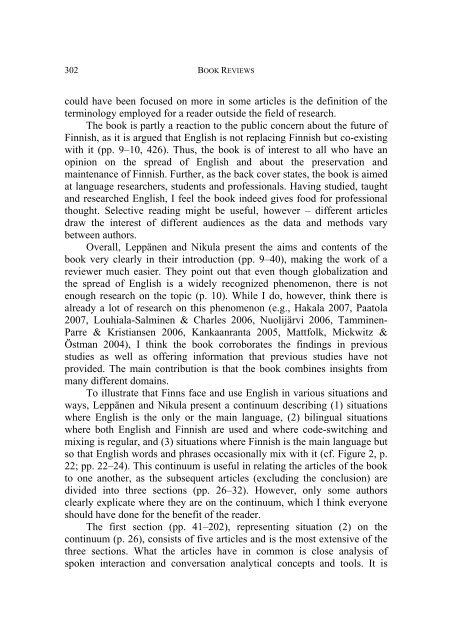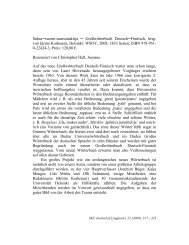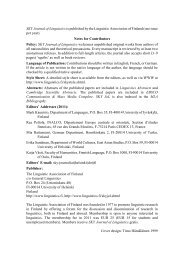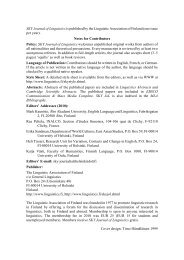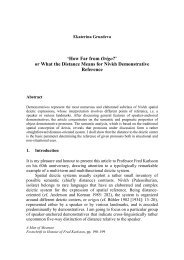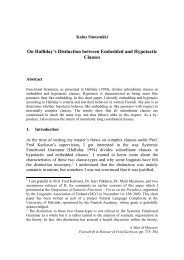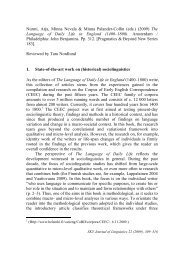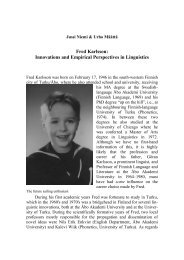Leppänen, Sirpa, Tarja Nikula & Leila Kääntä (eds.) (2008) Kolmas ...
Leppänen, Sirpa, Tarja Nikula & Leila Kääntä (eds.) (2008) Kolmas ...
Leppänen, Sirpa, Tarja Nikula & Leila Kääntä (eds.) (2008) Kolmas ...
You also want an ePaper? Increase the reach of your titles
YUMPU automatically turns print PDFs into web optimized ePapers that Google loves.
302<br />
BOOK REVIEWS<br />
could have been focused on more in some articles is the definition of the<br />
terminology employed for a reader outside the field of research.<br />
The book is partly a reaction to the public concern about the future of<br />
Finnish, as it is argued that English is not replacing Finnish but co-existing<br />
with it (pp. 9–10, 426). Thus, the book is of interest to all who have an<br />
opinion on the spread of English and about the preservation and<br />
maintenance of Finnish. Further, as the back cover states, the book is aimed<br />
at language researchers, students and professionals. Having studied, taught<br />
and researched English, I feel the book indeed gives food for professional<br />
thought. Selective reading might be useful, however – different articles<br />
draw the interest of different audiences as the data and methods vary<br />
between authors.<br />
Overall, <strong>Leppänen</strong> and <strong>Nikula</strong> present the aims and contents of the<br />
book very clearly in their introduction (pp. 9–40), making the work of a<br />
reviewer much easier. They point out that even though globalization and<br />
the spread of English is a widely recognized phenomenon, there is not<br />
enough research on the topic (p. 10). While I do, however, think there is<br />
already a lot of research on this phenomenon (e.g., Hakala 2007, Paatola<br />
2007, Louhiala-Salminen & Charles 2006, Nuolijärvi 2006, Tamminen-<br />
Parre & Kristiansen 2006, Kankaanranta 2005, Mattfolk, Mickwitz &<br />
Östman 2004), I think the book corroborates the findings in previous<br />
studies as well as offering information that previous studies have not<br />
provided. The main contribution is that the book combines insights from<br />
many different domains.<br />
To illustrate that Finns face and use English in various situations and<br />
ways, <strong>Leppänen</strong> and <strong>Nikula</strong> present a continuum describing (1) situations<br />
where English is the only or the main language, (2) bilingual situations<br />
where both English and Finnish are used and where code-switching and<br />
mixing is regular, and (3) situations where Finnish is the main language but<br />
so that English words and phrases occasionally mix with it (cf. Figure 2, p.<br />
22; pp. 22–24). This continuum is useful in relating the articles of the book<br />
to one another, as the subsequent articles (excluding the conclusion) are<br />
divided into three sections (pp. 26–32). However, only some authors<br />
clearly explicate where they are on the continuum, which I think everyone<br />
should have done for the benefit of the reader.<br />
The first section (pp. 41–202), representing situation (2) on the<br />
continuum (p. 26), consists of five articles and is the most extensive of the<br />
three sections. What the articles have in common is close analysis of<br />
spoken interaction and conversation analytical concepts and tools. It is


